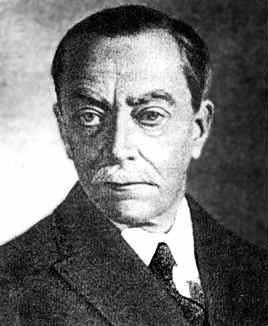
Vyacheslaw Vassilievich Stepanov
 المؤلف:
A P Youschkevitch
المؤلف:
A P Youschkevitch
 المصدر:
Biography in Dictionary of Scientific Biography
المصدر:
Biography in Dictionary of Scientific Biography
 الجزء والصفحة:
...
الجزء والصفحة:
...
 16-6-2017
16-6-2017
 1463
1463
Born: 4 September 1889 in Smolensk, Russia
Died: 22 July 1950 in Moscow, USSR

Vyacheslaw Vassilievich Stepanov's father was Vassily Ivanovich Stepanov, a high school teacher of history and geography in Smolensk. Vyacheslaw's mother was Alexandra Yakovlevna who was also a teacher, teaching in a girl's school. Stepanov was educated at the Smolensk High School and he graduated from the school in 1908 having excelled in science in general and mathematics in particular. He entered the Faculty of Physics and Mathematics of Moscow University to study mathematics and physics in 1908. He was supervised there by Dimitri Fedorovich Egorov but also influenced by Nikolai Nikolaevich Luzin who was a student of Egorov, then from 1909 an assistant lecturer. In 1912 Stepanov completed his first degree, but Egorov encouraged him to continue his studies so that he might prepare for a professorship.
Luzin, who was a little ahead of Stepanov, had travelled abroad visiting Göttingen where he had been inspired by Edmund Landau. Stepanov also spent some time in Göttingen where he attended lectures by both David Hilbert and Edmund Landau. He returned to Moscow in 1915 and, much influenced by Egorov and Luzin, he worked on periodic functions and differential equations. His first article studied the theory of the growth of functions building on the work by Paul du Bois-Reymond on the topic.
Stepanov was appointed as lecturer in Moscow in 1915, then from 1921 he was involved in training young scientists at the Research Institute of Mathematics and Mechanics which had been founded in that year. Egorov was appointed Director of the Research Institute in 1923 and Stepanov assisted his former research supervisor in running the Institute until Egorov was dismissed from his role in 1929. In 1928 Stepanov became professor at Moscow University. His most famous student was Aleksandr Osipovich Gelfond who graduated in 1935. Stepanov was appointed Director of the Research Institute of Mathematics and Mechanics in 1939, continuing to hold this post until his death. He also played an important role in the Moscow Mathematical Society [1]:-
He was also one of the most influential and active leaders of the Moscow Mathematical Society, owing, among other things, to his exceptional erudition and memory.
One of his most significant results is contained in two publications, the first in 1923 and the second two years later [1]:-
In works published in 1923 and 1925 Stepanov established the necessary and sufficient conditions under which a function of two variables, defined on a measurable plane set of finite measure greater than zero, possesses a total differential almost everywhere on that set.
Harald Bohr had introduced the notion of an almost periodic function and Stepanov constructed and investigated new classes of generalised almost periodic functions. In the qualitative theory of differential equations he worked on the general theory of dynamical systems studied by G D Birkhoff. In this area Stepanov extended work by Poincaré [1]:-
Besides writing articles on the study of almost periodic trajectories and on a generalisation of Birkhoff's ergodic theorem (which found an important application in statistical physics), Stepanov organised a seminar on the qualitative methods of the theory of differential equations (1932) that proved of great importance for the creation of the Soviet scientific school in this field.
A graduate-level text Qualitative Theory of Differential Equations by Stepanov and his student Viktor V Nemytskii became a classic, the 1960 edition being reprinted in 1989. It considers existence and continuity theorems, integral curves of a system of two differential equations, systems of n-differential equations, general theory of dynamical systems, systems with an integral invariant, and many related topics.
Four years before his death, Stepanov was honoured with election to the Academy of Sciences of the USSR.
Articles:
- A P Youschkevitch, Biography in Dictionary of Scientific Biography (New York 1970-1990).
- P S Aleksandrov and V V Nemytsky, Vyacheslaw Vassilievich Stepanov (Moscow, 1956).
- P S Aleksandrov, Obituary: Vyacheslav Vasil'evich Stepanov (Russian), Uspekhi Matem. Nauk (NS) (5) (39) (1950), 3-10.
- S S Demidov and T A Tokareva, V V Stepanov's letters to A P Yushkevich (Russian), Istor.-Mat. Issled. (2) 1 (36) (1) (1995), 26-27.
- B V Gnedenko, Reminiscences of Vyacheslav Vasil'evich Stepanov (on the centenary of his birth), Russian Math. Surveys 45 (6) (1990), 183-189.
- A D Myshkis and O A Oleinik, Vyacheslav Vasil'evich Stepanov (on the centenary of his birth) (Russian), Uspekhi Mat. Nauk 45 (1990) (6) (276), 165-169.
- A D Myshkis and O A Oleinik, Vyacheslav Vasil'evich Stepanov (on the centenary of his birth), Russian Math. Surveys 45 (6) (1990), 179-182.
- Obituary: Vyacheslav Vasil'evich Stepanov (Russian), Akad. Nauk SSSR Prikl. Mat. Meh. 14 (1950), 565-568.
 الاكثر قراءة في 1885to1889
الاكثر قراءة في 1885to1889
 اخر الاخبار
اخر الاخبار
اخبار العتبة العباسية المقدسة


